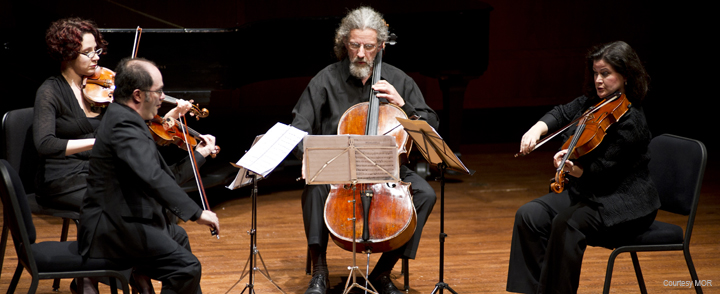By Peter A. Klein, Special to The Jewish Sound
It may surprise some to see the words “Schoenberg” and “Romantic” in the same sentence, but it’s not a misprint. Before he invented the modernist 12-tone method of composition, the Vienna-born composer Arnold Schoenberg (1874-1951) was steeped in the late Romanticism of Wagner, Strauss and Mahler. His works prior to about 1908 are written in that vein.
“Transfigured Night,” Music of Remembrance’s Nov. 9 fall concert, features a new ballet set to a lush, Romantic string sextet by the young Schoenberg. The choreography is by Donald Byrd, and will be danced by Byrd’s Spectrum Dance Theater. The concert also highlights the work of two little-known Dutch composers, plus cabaret music from the Terezín concentration camp.
Music of Remembrance is the Seattle-based organization devoted to performing and preserving music from and about the Holocaust.
Schoenberg composed “Transfigured Night” (“Verklärte Nacht”) in 1899, based on a poem by Richard Dehmel. A couple, newly in love, walk through a shadowy forest under a bright moon. The woman confesses that she is pregnant by another man, and fears the worst. The man replies, “But there is the glow of an inner warmth // from you in me, from me in you,” which will cause the child to become his child, and their child. And so the child, the couple, and the night itself are transfigured by their love.
Schoenberg escaped the Holocaust because he saw it coming. “But what is anti-Semitism to lead to if not to acts of violence?” he wrote a 1923 exchange of letters with the painter Wassily Kandinsky, who had reportedly made anti-Semitic remarks.
“For I have at last learned the lesson that has been forced upon me during this year, and I shall not ever forget it,” wrote Schoenberg. “It is that I am not a German, not a European, indeed perhaps scarcely even a human being (at least, the Europeans prefer the worst of their race to me), but I am a Jew.”
These painful words came from a man who believed that his own work represented the natural evolution of German music. Schoenberg had even converted to Lutheranism in 1898, perhaps because he identified so closely with Germanic musical culture, and perhaps as a defense (albeit ultimately useless) against the growing anti-Semitism of the time.
In 1933, shortly after Hitler came to power, Schoenberg left Germany forever. On his way to America, he formally converted back to Judaism at a Paris synagogue (with artist Marc Chagall serving as a witness), and called himself a Jew ever after. Schoenberg settled in Los Angeles and remained there until his death.
Also on the program, MOR artistic director Mina Miller is excited to be presenting the works of two Dutch Jewish composers murdered by the Nazis.
“There’s not as much attention paid to them, and their stories need to be told,” she says.
Leo Smit (1900-1943) was educated in Amsterdam. He spent nine years in Paris, where he absorbed the lighthearted, eclectic culture of the French capital between the wars. Smit met many of the leading composers of the day, including Ravel, Stravinsky and Poulenc. Darius Milhaud was a significant influence. Smit wrote music for orchestra, chamber ensembles, and the cinema, with numerous performances in Holland before the war. Smit’s “Sextet for Wind Quintet and Piano” is a jaunty, jazz-inflected Neoclassical piece with a bittersweet central slow movement, and brisk outer movements that evoke colorful Parisian streets and nightclubs.
Dick Kattenburg (1919-1944) went into hiding shortly after his graduation from the Brussels Conservatory in 1941. He studied violin and theory, but was mostly self-taught as a composer. Kattenburg corresponded with Smit regarding compositional technique. He wrote much music during the war, which was presumed lost.
A sonata for flute surfaced in 2000, when the elderly performer for whom it was written, an Auschwitz survivor, gave the original manuscript to flutist Eleonore Pameijer as a birthday present. One of Pameijer’s performances sparked the curiosity of the composer’s niece, who searched through her late mother’s attic, and discovered 30 Kattenburg manuscripts.
Two of those pieces will be heard at the MOR concert. “Escapades” for two violins incorporates folk-like elements and popular music, seasoned with a good-humored French-modern “sauce.” The snappy and sparkling “Tap Dance,” for two pianos and a dancer or percussion instrument, will include a Spectrum dancer and choreography by Byrd.
Rounding out the program, mezzo-soprano Julia Benzinger will perform a medley of songs and satires from the Terezín cabarets. Dubbed the “Paradise Ghetto” for propaganda purposes, Terezín was a transit camp feeding the death camps that held many prominent Jewish artists. The Nazis allowed a cultural life to exist at the camp, including cabarets in Czech and German. Though a tool to pacify the prisoners, the cabarets also helped make existence at the camp more bearable.
